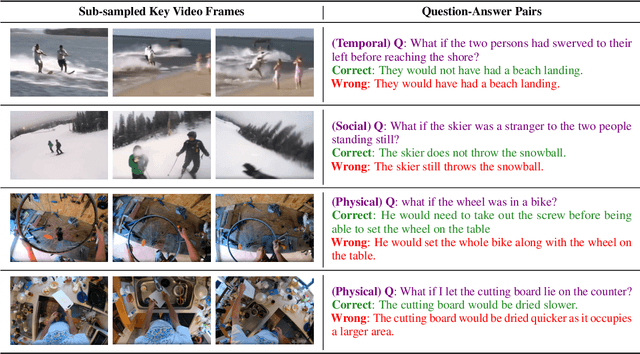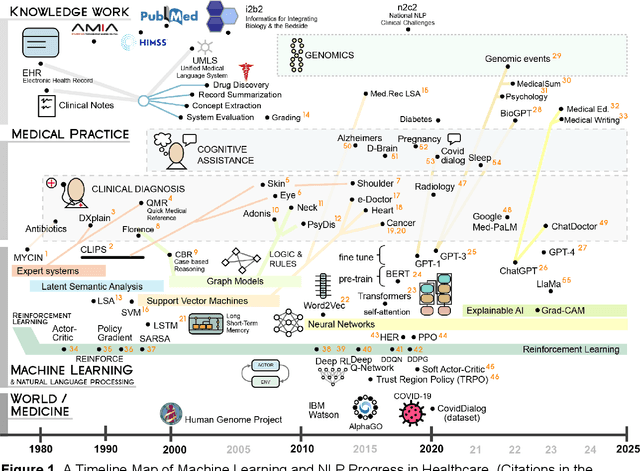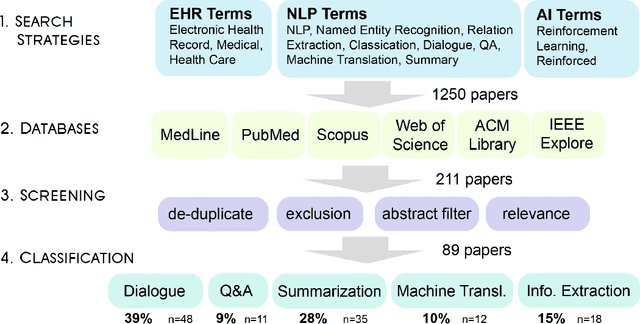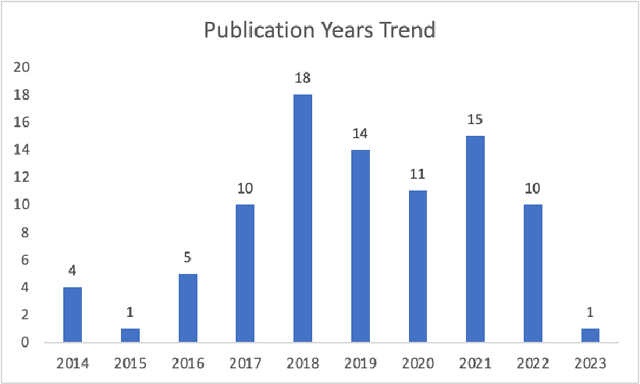Yu Hou
Uncertainty-Aware Large Language Models for Explainable Disease Diagnosis
May 06, 2025Abstract:Explainable disease diagnosis, which leverages patient information (e.g., signs and symptoms) and computational models to generate probable diagnoses and reasonings, offers clear clinical values. However, when clinical notes encompass insufficient evidence for a definite diagnosis, such as the absence of definitive symptoms, diagnostic uncertainty usually arises, increasing the risk of misdiagnosis and adverse outcomes. Although explicitly identifying and explaining diagnostic uncertainties is essential for trustworthy diagnostic systems, it remains under-explored. To fill this gap, we introduce ConfiDx, an uncertainty-aware large language model (LLM) created by fine-tuning open-source LLMs with diagnostic criteria. We formalized the task and assembled richly annotated datasets that capture varying degrees of diagnostic ambiguity. Evaluating ConfiDx on real-world datasets demonstrated that it excelled in identifying diagnostic uncertainties, achieving superior diagnostic performance, and generating trustworthy explanations for diagnoses and uncertainties. To our knowledge, this is the first study to jointly address diagnostic uncertainty recognition and explanation, substantially enhancing the reliability of automatic diagnostic systems.
Retrieval-augmented in-context learning for multimodal large language models in disease classification
May 04, 2025Abstract:Objectives: We aim to dynamically retrieve informative demonstrations, enhancing in-context learning in multimodal large language models (MLLMs) for disease classification. Methods: We propose a Retrieval-Augmented In-Context Learning (RAICL) framework, which integrates retrieval-augmented generation (RAG) and in-context learning (ICL) to adaptively select demonstrations with similar disease patterns, enabling more effective ICL in MLLMs. Specifically, RAICL examines embeddings from diverse encoders, including ResNet, BERT, BioBERT, and ClinicalBERT, to retrieve appropriate demonstrations, and constructs conversational prompts optimized for ICL. We evaluated the framework on two real-world multi-modal datasets (TCGA and IU Chest X-ray), assessing its performance across multiple MLLMs (Qwen, Llava, Gemma), embedding strategies, similarity metrics, and varying numbers of demonstrations. Results: RAICL consistently improved classification performance. Accuracy increased from 0.7854 to 0.8368 on TCGA and from 0.7924 to 0.8658 on IU Chest X-ray. Multi-modal inputs outperformed single-modal ones, with text-only inputs being stronger than images alone. The richness of information embedded in each modality will determine which embedding model can be used to get better results. Few-shot experiments showed that increasing the number of retrieved examples further enhanced performance. Across different similarity metrics, Euclidean distance achieved the highest accuracy while cosine similarity yielded better macro-F1 scores. RAICL demonstrated consistent improvements across various MLLMs, confirming its robustness and versatility. Conclusions: RAICL provides an efficient and scalable approach to enhance in-context learning in MLLMs for multimodal disease classification.
Language Models Predict Empathy Gaps Between Social In-groups and Out-groups
Mar 02, 2025Abstract:Studies of human psychology have demonstrated that people are more motivated to extend empathy to in-group members than out-group members (Cikara et al., 2011). In this study, we investigate how this aspect of intergroup relations in humans is replicated by LLMs in an emotion intensity prediction task. In this task, the LLM is given a short description of an experience a person had that caused them to feel a particular emotion; the LLM is then prompted to predict the intensity of the emotion the person experienced on a numerical scale. By manipulating the group identities assigned to the LLM's persona (the "perceiver") and the person in the narrative (the "experiencer"), we measure how predicted emotion intensities differ between in-group and out-group settings. We observe that LLMs assign higher emotion intensity scores to in-group members than out-group members. This pattern holds across all three types of social groupings we tested: race/ethnicity, nationality, and religion. We perform an in-depth analysis on Llama-3.1-8B, the model which exhibited strongest intergroup bias among those tested.
GRACE: A Granular Benchmark for Evaluating Model Calibration against Human Calibration
Feb 27, 2025Abstract:Language models are often miscalibrated, leading to confidently incorrect answers. We introduce GRACE, a benchmark for language model calibration that incorporates comparison with human calibration. GRACE consists of question-answer pairs, in which each question contains a series of clues that gradually become easier, all leading to the same answer; models must answer correctly as early as possible as the clues are revealed. This setting permits granular measurement of model calibration based on how early, accurately, and confidently a model answers. After collecting these questions, we host live human vs. model competitions to gather 1,749 data points on human and model teams' timing, accuracy, and confidence. We propose a metric, CalScore, that uses GRACE to analyze model calibration errors and identify types of model miscalibration that differ from human behavior. We find that although humans are less accurate than models, humans are generally better calibrated. Since state-of-the-art models struggle on GRACE, it effectively evaluates progress on improving model calibration.
Natural Language Inference Improves Compositionality in Vision-Language Models
Oct 29, 2024



Abstract:Compositional reasoning in Vision-Language Models (VLMs) remains challenging as these models often struggle to relate objects, attributes, and spatial relationships. Recent methods aim to address these limitations by relying on the semantics of the textual description, using Large Language Models (LLMs) to break them down into subsets of questions and answers. However, these methods primarily operate on the surface level, failing to incorporate deeper lexical understanding while introducing incorrect assumptions generated by the LLM. In response to these issues, we present Caption Expansion with Contradictions and Entailments (CECE), a principled approach that leverages Natural Language Inference (NLI) to generate entailments and contradictions from a given premise. CECE produces lexically diverse sentences while maintaining their core meaning. Through extensive experiments, we show that CECE enhances interpretability and reduces overreliance on biased or superficial features. By balancing CECE along the original premise, we achieve significant improvements over previous methods without requiring additional fine-tuning, producing state-of-the-art results on benchmarks that score agreement with human judgments for image-text alignment, and achieving an increase in performance on Winoground of +19.2% (group score) and +12.9% on EqBen (group score) over the best prior work (finetuned with targeted data).
Collaborative Filtering Based on Diffusion Models: Unveiling the Potential of High-Order Connectivity
Apr 22, 2024



Abstract:A recent study has shown that diffusion models are well-suited for modeling the generative process of user-item interactions in recommender systems due to their denoising nature. However, existing diffusion model-based recommender systems do not explicitly leverage high-order connectivities that contain crucial collaborative signals for accurate recommendations. Addressing this gap, we propose CF-Diff, a new diffusion model-based collaborative filtering (CF) method, which is capable of making full use of collaborative signals along with multi-hop neighbors. Specifically, the forward-diffusion process adds random noise to user-item interactions, while the reverse-denoising process accommodates our own learning model, named cross-attention-guided multi-hop autoencoder (CAM-AE), to gradually recover the original user-item interactions. CAM-AE consists of two core modules: 1) the attention-aided AE module, responsible for precisely learning latent representations of user-item interactions while preserving the model's complexity at manageable levels, and 2) the multi-hop cross-attention module, which judiciously harnesses high-order connectivity information to capture enhanced collaborative signals. Through comprehensive experiments on three real-world datasets, we demonstrate that CF-Diff is (a) Superior: outperforming benchmark recommendation methods, achieving remarkable gains up to 7.29% compared to the best competitor, (b) Theoretically-validated: reducing computations while ensuring that the embeddings generated by our model closely approximate those from the original cross-attention, and (c) Scalable: proving the computational efficiency that scales linearly with the number of users or items.
A New Method of Pixel-level In-situ U-value Measurement for Building Envelopes Based on Infrared Thermography
Jan 13, 2024Abstract:The potential energy loss of aging buildings traps building owners in a cycle of underfunding operations and overpaying maintenance costs. Energy auditors intending to generate an energy model of a target building for performance assessment may struggle to obtain accurate results as the spatial distribution of temperatures is not considered when calculating the U-value of the building envelope. This paper proposes a pixel-level method based on infrared thermography (IRT) that considers two-dimensional (2D) spatial temperature distributions of the outdoor and indoor surfaces of the target wall to generate a 2D U-value map of the wall. The result supports that the proposed method can better reflect the actual thermal insulation performance of the target wall compared to the current IRT-based methods that use a single-point room temperature as input.
ACQUIRED: A Dataset for Answering Counterfactual Questions In Real-Life Videos
Nov 02, 2023



Abstract:Multimodal counterfactual reasoning is a vital yet challenging ability for AI systems. It involves predicting the outcomes of hypothetical circumstances based on vision and language inputs, which enables AI models to learn from failures and explore hypothetical scenarios. Despite its importance, there are only a few datasets targeting the counterfactual reasoning abilities of multimodal models. Among them, they only cover reasoning over synthetic environments or specific types of events (e.g. traffic collisions), making them hard to reliably benchmark the model generalization ability in diverse real-world scenarios and reasoning dimensions. To overcome these limitations, we develop a video question answering dataset, ACQUIRED: it consists of 3.9K annotated videos, encompassing a wide range of event types and incorporating both first and third-person viewpoints, which ensures a focus on real-world diversity. In addition, each video is annotated with questions that span three distinct dimensions of reasoning, including physical, social, and temporal, which can comprehensively evaluate the model counterfactual abilities along multiple aspects. We benchmark our dataset against several state-of-the-art language-only and multimodal models and experimental results demonstrate a significant performance gap (>13%) between models and humans. The findings suggest that multimodal counterfactual reasoning remains an open challenge and ACQUIRED is a comprehensive and reliable benchmark for inspiring future research in this direction.
A Review of Reinforcement Learning for Natural Language Processing, and Applications in Healthcare
Oct 23, 2023



Abstract:Reinforcement learning (RL) has emerged as a powerful approach for tackling complex medical decision-making problems such as treatment planning, personalized medicine, and optimizing the scheduling of surgeries and appointments. It has gained significant attention in the field of Natural Language Processing (NLP) due to its ability to learn optimal strategies for tasks such as dialogue systems, machine translation, and question-answering. This paper presents a review of the RL techniques in NLP, highlighting key advancements, challenges, and applications in healthcare. The review begins by visualizing a roadmap of machine learning and its applications in healthcare. And then it explores the integration of RL with NLP tasks. We examined dialogue systems where RL enables the learning of conversational strategies, RL-based machine translation models, question-answering systems, text summarization, and information extraction. Additionally, ethical considerations and biases in RL-NLP systems are addressed.
Graph Neural Network-Aided Exploratory Learning for Community Detection with Unknown Topology
Apr 10, 2023

Abstract:In social networks, the discovery of community structures has received considerable attention as a fundamental problem in various network analysis tasks. However, due to privacy concerns or access restrictions, the network structure is often unknown, thereby rendering established community detection approaches ineffective without costly network topology acquisition. To tackle this challenge, we present META-CODE, a novel end-to-end solution for detecting overlapping communities in networks with unknown topology via exploratory learning aided by easy-to-collect node metadata. Specifically, META-CODE consists of three iterative steps in addition to the initial network inference step: 1) node-level community-affiliation embeddings based on graph neural networks (GNNs) trained by our new reconstruction loss, 2) network exploration via community affiliation-based node queries, and 3) network inference using an edge connectivity-based Siamese neural network model from the explored network. Through comprehensive evaluations using five real-world datasets, we demonstrate that META-CODE exhibits (a) its superiority over benchmark community detection methods, (b) empirical evaluations as well as theoretical findings to see the effectiveness of our node query, (c) the influence of each module, and (d) its computational efficiency.
 Add to Chrome
Add to Chrome Add to Firefox
Add to Firefox Add to Edge
Add to Edge